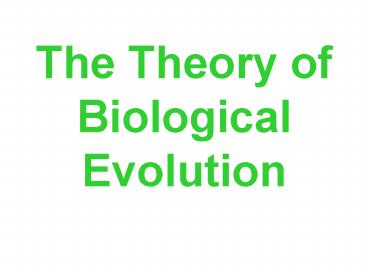The Theory of Biological Evolution - PowerPoint PPT Presentation
Title:
The Theory of Biological Evolution
Description:
The Theory of Biological Evolution The Theory of Evolution, defined: All living species are descendants of ancestral species and are different from present day ... – PowerPoint PPT presentation
Number of Views:149
Avg rating:3.0/5.0
Title: The Theory of Biological Evolution
1
The Theory of Biological Evolution
2
The Theory of Evolution, defined
- All living species are descendants of ancestral
species and are different from present day ones
due to the cumulative change in the genetic
composition of a population - Sooo in a nutshell, populations of living things
look and behave differently because over time,
their DNA has changed but how?
3
Charles Darwin (1809-1882)
- Father of the theory of Evolution
- Suggested that natural selection is the mechanism
by which species evolve over geologic time. - Proposed Descent with Modification
- All organisms on Earth are related
- through some unknown ancestral
- type that lived long ago.
4
History of the Theory
- Evolutionary theory was developed through many
generations of scientists interpreting new
evidence to refine and expand our understanding
of biological change across time. - Darwin and Wallace (Evolution)
- Gregor Mendel (Genetics)
- Franklin, Watson Crick (Genetics)
5
The Nuts and Bolts of Evolution
- Evolution A cumulative change in the inherited
characteristics of population. - Population!! Is what changes.
- Evolution is like a tree many branches emerged
from a common beginning, some branches died off
(extinction), others branched multiple times
(present-day diversity)
6
The Nuts and Bolts of Evolution
- The great diversity of living organisms is the
result of over 3.5 billion years of evolution,
filling every available niche with life forms. - Niche The area within a habitat occupied by an
organism OR the ecological role of an organism
within its community. - Ive found my niche in society, I am a social
worker - The arctic fish have found theirniche in cold
waters due to the adaptations in their cell
membranes
7
Niche The area within a habitat occupied by an
organism OR the function of an organism within
its community.
- Discuss with your neighbors a possible niche for
- Elephant
- Whale
- Fish
- Why have these life forms filled these niches?
- How have these life forms filled these niches?
8
The Origin of Species
- Darwin developed two main ideas
- Evolution explains lifes unity and diversity
- Natural selection is a cause of adaptive evolution
9
- To Darwin, the history of life is like a tree.
- ?multiple branchings from a common trunk to the
tips of the youngest twigs that represent the
diversity of living organisms
10
The Six Main Points of Darwins Theory of
EvolutionObservations and Inferences
11
1. Overproduction
- Most species produce far more offspring than are
needed to maintain the population. - Species populations remain more or less constant
(stable) because a small fraction of offspring
live long enough to reproduce.
12
2. Competition
- Living space and food are limited, so offspring
from each generation must compete among
themselves in order to live. - Only a small fraction can possibly survive long
enough to reproduce.
13
3. Genetic Variation
- Characteristics in individuals in any species are
not exactly alike. - Ex Differences for Homo sapiens (humans) can be
exact size or shape of body, strength in running,
or resistance to disease. - These differences are considered to be the
variations within a species. What causes slight
variations between individuals?
14
4. Adaptation
- An adaptation is an inherited trait that
increases an organisms chance of survival and
reproduction in a given environment. - The word adapt is a VERBAL SHORTCUT and I hate
it. ?
15
5. Natural Selection
- Nature/environment selects for living organisms
with better suited inherited traits to survive
and reproduce. - Variation caused by within a species (ex
giraffe) may make them better equipped for
survival. - Offspring inherit these better traits, and as a
whole the population improves for that particular
environment.
16
5. Natural Selection, cont.
- Natural Selection does not move in a
pre-determined direction! The changing earth
determines what will and can survive.
17
6. Speciation
- Over many generations, favorable adaptations (in
a particular environment) gradually accumulate a
in species and bad ones (in a particular
environment) disappear. - Eventually, accumulated changes become so great,
the result is a new species. - Formation of a new species is called Speciation
and it takes many, many generations to do.
18
The four factors
- Overproduction
- Competition
- Genetic Variation
- Natural Selection
- Biological Evolution is a consequence of these 4
factors - they work together to impact any living
population
19
Which one of Darwins Six Points do the following
pictures show?
20
Diagram 1
21
Diagram 2
22
Diagram 3
23
Diagram 4
24
Key
25
Competitionor Overpopulation
26
Variation
27
Speciation
28
Adaptation
29
Evolution Review Packet
- Use the lecture notes!
30
(No Transcript)
31
Questions to ConsiderCopy these in your journal
- Is it possible to adapt to a new environment in
ones lifetime, and pass on those new adaptations
to offspring? - Did the people who participated in musical chairs
ever change in their lifetime? - What was it that changed?
- Using two or more examples, what exactly was it
that changed over time (evolved)? - Did evolution of the organisms in musical chairs
ever stop? Explain why.































